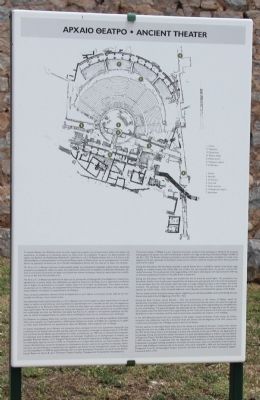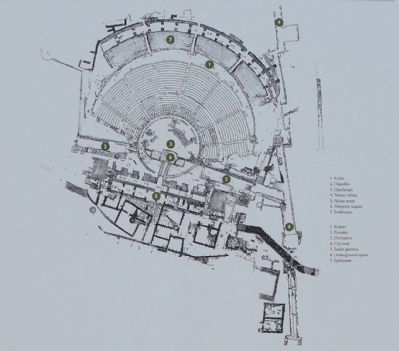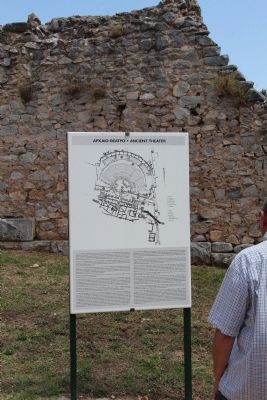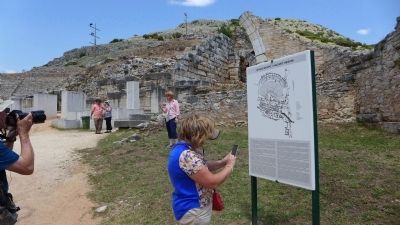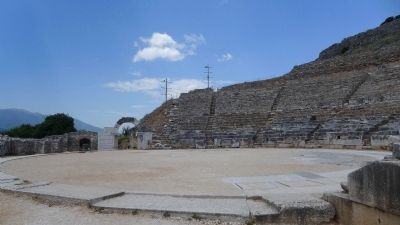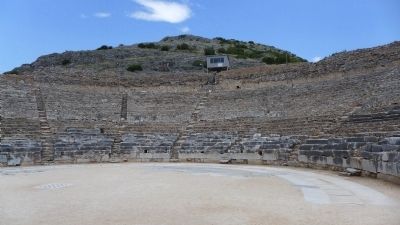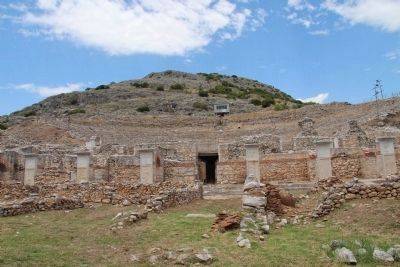Near Filippi in Kavala, Macedonia and Thrace, Greece — Ελλάδα (Southeastern Europe, Balkan Peninsula)
Ancient Theater
The ancient theater of Philippi is a very important monument, located on the southeastern hillside of the acropolis leaning against the eastern city wall. Its initial phase is dated in the reign of the King of Macedonia Philip II (middle of the 4th c. BC). The Roman colonizers continued to use the Hellenistic theater but they remodeled it in order to be adapted to the new spectacles of the Roman society and to receive a multitude of spectators from the city and the towns of the colony.
During the 2nd century AD the theater acquired a typically Roman form; it included a majestic three-story stage building, an orchestra paved with marble slabs and a koilon that was extended above the parodoi, covered with vaulted structures. The south portico of the stage building, which bears relief plaques with representations referring to Dionysos (maenads and others) on the pillar fronts is preserved.
During the 3rd century AD the theater was transformed into an arena for animal fights. The proscenium was demolished, the first rows of seats were removed from the koilon and a wall was built with a fence for the protection of the spectators from the wild animals, which were kept in a large underground space at the southern end of the orchestra. The epitheater must have been constructed during this period. This was a vaulted structure at the topmost part of the koilon, which contained additional rows of benches and increased the capacity of the theater.
The two arches used for bracing the theater against neighboring city-wall were probably constructed during the Late Roman times (end of the 3rd/beginning of the 4th c. AD).
During the Early Christian period (5th-6th c. AD) the performances at the theater of Philippi ceased. Its abandonment is probably connected to the prevalence of Christianity and the new morals that were not congruent with the animal fights or theatrical performances. The portico at the back of the stage building was remodeled into an area of workshops. The great earthquake that destroyed the city of Philippi at the beginning of the 7th century AD probably caused the destruction of the stage-building by fire. From then onwards the theater was systemically demolished, so that its members could be used as construction material for the creation of new buildings.
In the early Byzantine period the area southeast of the theater housed workshops. Finally, during the Turkish occupation the cobblestone road that connected Kavala and Drama until the beginning of the 20th century and crossed the archaeological site of Philippi, passed in front of the theater.
The first sources of information found today about the theater
are provided by European travelers who started visiting the area from the middle of the 16th century onwards. The systematic excavations of the theater started in 1921-1927 by the French School of Archaeology at Athens and continued at the end of 1950s by the department of Archaeology. During this period the theater was altered in a quick and slipshod fashion in order to host the Festival of Philippi and Thasos. The 18th Ephorate of Prehistoric and Classical Antiquities in Kavala resumed the excavations in 1974 and since 1993 it co-operated with the Department of Architecture of the Aristotelian University of Thessalonica in a project including excavations and studies of conservation, repair and restoration of the orchestra, parade, stage building and retaining walls of the theater; which were completed in 2009 with the financing from the Management Fund for Archaeological Projects Execution and from the Second and Third Community Support Framework (B & C CSF).
Topics. This historical marker is listed in this topic list: Notable Places. A significant historical year for this entry is 1974.
Location. 41° 0.766′ N, 24° 17.237′ E. Marker is near Filippi, Macedonia and Thrace, in Kavala. Marker can be reached from Agiou Christoforou west of Filippou, on the right when traveling west. This marker is located in the archaeological park, and is one of the first markers that one comes to after leaving the visitor center and beginning the tour of the archaeological park. Touch for map. Marker is in this post office area: Filippi, Macedonia and Thrace 640 03, Greece. Touch for directions.
Other nearby markers. At least 8 other markers are within 14 kilometers of this marker, measured as the crow flies. Philippi (within shouting distance of this marker); Archeological Area Filippi (about 150 meters away, measured in a direct line); Basilica (about 210 meters away); Christian Philippi (about 240 meters away); Annexes to Octagon at Philippi (approx. 0.2 kilometers away); The Octagon at Philippi (approx. 0.3 kilometers away); Black Sea - Silk Road (approx. 11.4 kilometers away); Neapolis-Christoupolis-Kavala (approx. 13.6 kilometers away). Touch for a list and map of all markers in Filippi.
Related markers. Click here for a list of markers that are related to this marker. To better understand the relationship, study each marker in the order shown.
Credits. This page was last revised on March 22, 2022. It was originally submitted on June 27, 2015, by Dale K. Benington of Toledo, Ohio. This page has been viewed 544 times since then and 37 times this year. Photos: 1, 2, 3, 4, 5, 6, 7. submitted on June 27, 2015, by Dale K. Benington of Toledo, Ohio.
